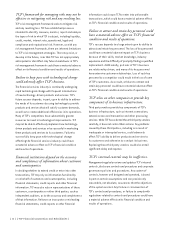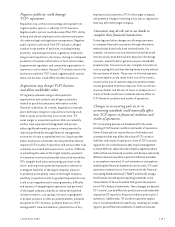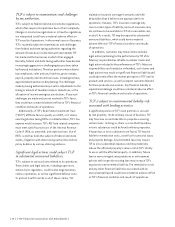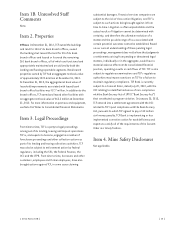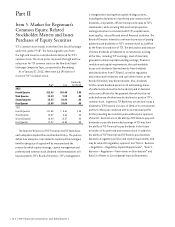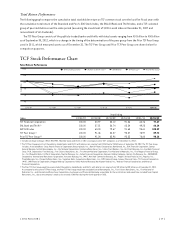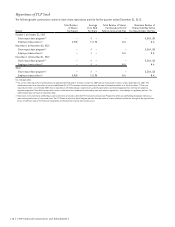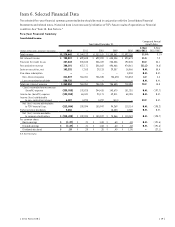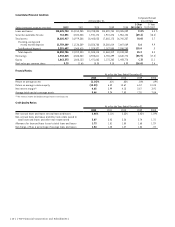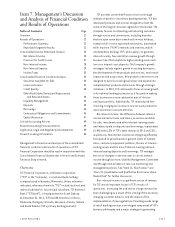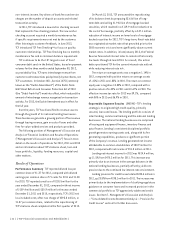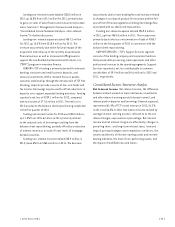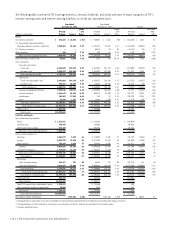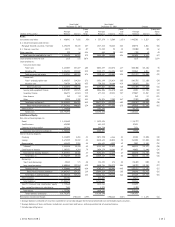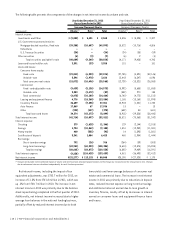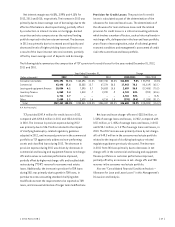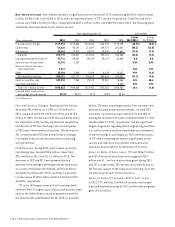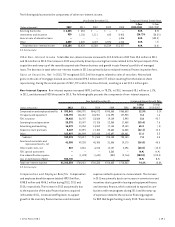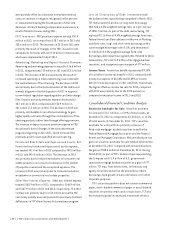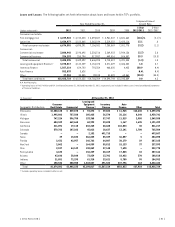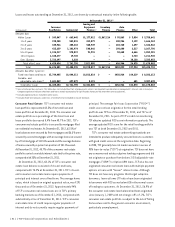TCF Bank 2012 Annual Report Download - page 38
Download and view the complete annual report
Please find page 38 of the 2012 TCF Bank annual report below. You can navigate through the pages in the report by either clicking on the pages listed below, or by using the keyword search tool below to find specific information within the annual report.non-interest income. Key drivers of bank fees and service
charges are the number of deposit accounts and related
transaction activity.
In 2011, TCF introduced a new anchor checking account
that replaced its free checking product. This new anchor
checking account required a monthly maintenance fee
if specific requirements were not met by the customer.
After listening to customer feedback, in June 2012,
TCF introduced TCF Free CheckingSM to focus on quality
customer relationships. TCF Free Checking has no monthly
maintenance fee and no minimum balance requirement.
TCF continues to be the 15th largest issuer of Visa®
consumer debit cards in the United States, based on payment
volumes for the three months ended September 30, 2012,
as provided by Visa. TCF earns interchange revenue from
customer card transactions paid primarily by merchants, not
TCF’s customers. In October 2011, Section 1075 (commonly
known as the “Durbin Amendment”) of the Dodd-Frank
Wall Street Reform and Consumer Protection Act of 2010
(the “Dodd-Frank Act”) went into effect, which reduced the
amount of interchange revenue recognized on transaction
activity. For 2012, the Durbin Amendment was in effect for
the full year.
Over the years, TCF has diversified its revenue sources
through the growth of its national lending businesses.
These businesses generate a growing portion of fee revenue
through leasing revenue, gain on sale of loans and other
fees for value-added services and products provided.
The following portions of Management’s Discussion and
Analysis of Financial Condition and Results of Operations
(“Management’s Discussion and Analysis”) focus in more
detail on the results of operations for 2012, 2011 and 2010
and on information about TCF’s balance sheet, loan and
lease portfolio, liquidity, funding resources, capital and
other matters.
Results of Operations
Performance Summary TCF reported diluted loss per
common share of $1.37 for 2012, compared with diluted
earnings per common share of 71 cents for 2011 and $1.08
for 2010. TCF reported a net loss of $218.5 million for the
year ended December 31, 2012, compared with net income
of $109.4 million and $150.9 million for the years ended
December 31, 2011 and 2010, respectively. TCF’s 2012 net
loss included a net, after-tax charge of $295.8 million, or
$1.87 per common share, related to the repositioning of
TCF’s balance sheet completed in the first quarter of 2012.
On March 13, 2012, TCF announced the repositioning
of its balance sheet by prepaying $3.6 billion of long-
term debt and selling $1.9 billion of mortgage-backed
securities, which resulted in a $119.9 million reduction to
the cost of borrowings, partially offset by a $47.1 million
reduction of interest income on lower levels of mortgage-
backed securities for 2012. TCF’s long-term, fixed-rate debt
was originated at market rates that prevailed prior to the
2008 economic crisis and were significantly above current
market rates. In addition, in late January 2012, the Federal
Reserve forecasted interest rates to remain at historically
low levels through at least 2014. As a result, this action
better positioned TCF for the current interest rate outlook
while reducing interest rate risk.
The return on average assets was a negative 1.14% in
2012, compared with positive returns on average assets
of .61% in 2011 and .85% in 2010. The return on common
equity was a negative 13.33% in 2012, compared with a
positive return of 6.32% in 2011 and 10.67% in 2010. The
effective income tax rate for 2012 was 39.1%, compared
with 36% in 2011 and 36.9% in 2010.
Reportable Segment Results LENDING–TCF’s lending
strategy is to originate high credit quality, primarily
secured, loans and leases. The lending portfolio consists of
retail lending, commercial banking and the national lending
businesses. The national lending businesses are comprised
of leasing and equipment finance, inventory finance and
auto finance. Lending’s consistent disciplined portfolio
growth generates earning assets and, along with its fee
generating capabilities, produces a significant portion
of the Company’s revenue. Lending generated net income
attributable to common stockholders of $30.9 million for
2012, compared with net income of $31.5 million in 2011.
Lending net interest income for 2012 was $524.4 million,
up 11.5% from $470.2 million for 2011. This increase was
primarily due to an increase in the average balances in the
national lending businesses, partially offset by yield com-
pression due to the continued low interest rate environment.
Lending provision for credit losses totaled $245.4 million in
2012, up 23.8% from $198.1 million for 2011. The increase was
primarily due to the implementation of clarifying regulatory
guidance on consumer loans and increased provision in the
commercial portfolio as TCF aggressively addressed credit
issues. See Item 7. Management’s Discussion and Analysis
— “Consolidated Income Statement Analysis — Provision for
Credit Losses” section for further discussion.
{ 22 } { TCF Financial Corporation and Subsidiaries }


